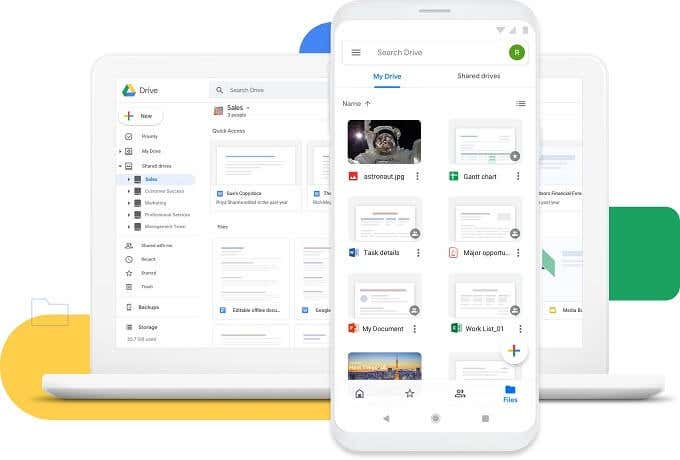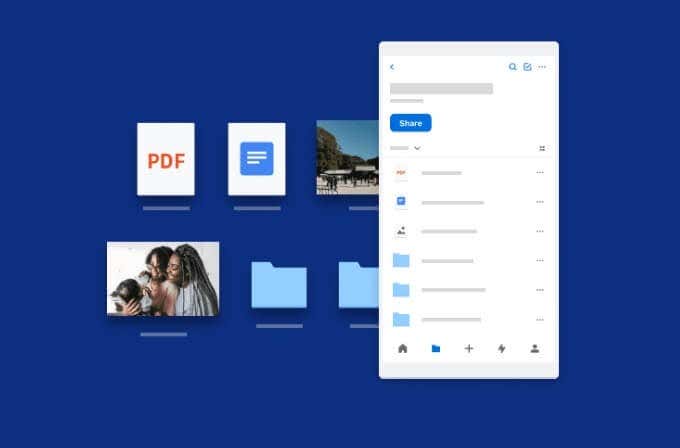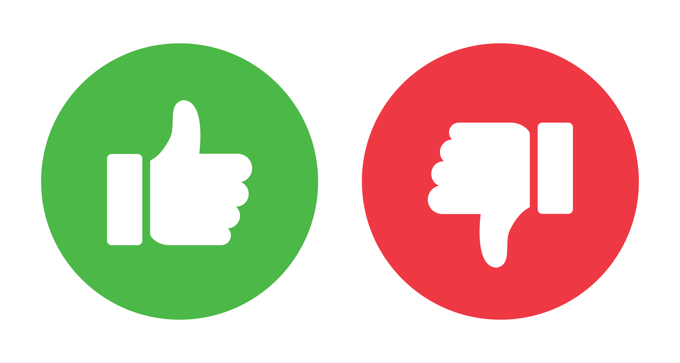That being said, different cloud providers aren’t interchangeable. They each have their own pros and cons. Which is why we’re comparing Dropbox vs Google Drive, two of the most popular choices for the majority of users.
Dropbox Vs Google Drive: What You Get For Free
Both of these services let you use them for free, but they don’t offer exactly the same amount of storage or features if you put no money down. Dropbox Basic offers you 2GB of space. This is a rather small amount of space in this day and age, but if you only need to keep a few small documents and moderate quality photos, it will do in a pinch. Dropbox Basic users are also limited to three devices in total. For example, a laptop, tablet and smartphone. Dropbox also offers Dropbox Paper, a cloud-based collaboration tool that lets you work on documents and communicate with team members. There’s also DropBox integration for applications like Microsoft Word, which helps keep track of document versions for office files stored and shared through your Dropbox. The free version of Google Drive currently offers a 17GB allocation of space. That’s far more reasonable for general use. If you’re only storing a few work documents and photos, then it’s likely this chunk of storage will serve you for a long time. Of course, you also get a Gmail account, access to the full Google Drive suite and quite possibly the best set of online collaboration and sharing tools of any cloud software service today. So if you mainly want cloud storage as a way to work seamlessly with others, Google Drive is already the stronger contender here. In the end, the sheer lack of storage space of the DropBox Basic offering makes it little more than a trial by another name. So if you’re not looking to spend any money at all, we have a hard time recommending it.
The Best Things About Google Drive
Google Drive is so much more than a cloud storage solution. Drive itself is the unifying hub that ties together all the various Google services. Your Gmail address is the key to it all and, of course, all of your mail takes up a part of the storage in your drive. Drive is also the backbone of Google’s suite of cloud applications. Google Docs, Google Sheets and Google Slides are three important ones, but there’s a sizable selection on offer. When you create a new document with one of these applications, it’s stored in your Google Drive. In the past, offline use and integration has been a significant point of weakness for Google Drive, but thanks to browser extensions and the excellent Backup and Sync application, we consider those particular gaps filled.
The Best Things About Dropbox
One of Dropbox’s greatest strengths is its simplicity. If you install the Dropbox application on your desktop computer, it acts as a simple system folder. Moving files in and out of the cloud is no different from using local file transfer. It’s also dead easy to get shareable links and see exactly which files have been synced or not. All in all, Dropbox just works and that’s a big plus point in its favor. However, Google Drive has caught up in the last few years. The Backup and Sync application gives it effectively the same form and function as Dropbox. We do however think that the Dropbox mobile application is much more user friendly and easy to navigate compared to Google Drive. Partly because Dropbox has a much smaller set of functions squeezed into the same space. We are however very impressed with Dropbox Rewind, which is a powerful and intuitive way to roll back changes to your Dropbox that happen either by accident or thanks to malicious actors. Google Drive also lets you revert file versions and recover deleted items from the Trash, but it has nothing as good as this at the time of writing.
Dropbox Vs Google Drive Pricing Compared
While it’s nice that both services offer a free tier for you to try, you’ll need to shell out a little cash in order to get the most out of them. We’re only focusing on the consumer-grade or individual options here rather than the business or enterprise products. Starting with Dropbox, these are the most relevant plans for the average user:
Dropbox Plus 2TB $9.99 per month (billed annually) or $12.99 billed monthly.Dropbox Professional 3TB $16.58 per month (billed annually) or $19.99 per month billed monthly.
Dropbox doesn’t just offer different storage sizes between these two tiers. There are other feature differences as well. For example, the Professional option provides 180 days of rewind rather than 30, as with Plus. On the Google side, the storage service is called Google One and the pricing breaks down like this:
$2.99 per month: 200 GB$9.99 per month: 2 TB$99.99 per month: 10 TB$199.99 per month: 20 TB$299.99 per month: 30 TB
Only the 200GB and 2TB plans have an annual option, which essentially give you two months out of the year for free. Google offers a better deal on every level and sadly Dropbox does not have smaller plans. We have to give the prize to Google here, Dropbox is just not competitive in pure dollar terms.
Dropbox Vs Google Drive: Which Is For You?
If you’re looking for a simple, straightforward cloud storage solution that simply acts as a hard drive in the cloud, Dropbox is probably the best choice for you. It’s simpler to navigate and manage your files and easy to sync files on your devices. One rather sizable issue is the lack of a family plan. Google Drive, OneDrive and Apple iCloud all offer options to share a pool of cloud storage among a group of people, such as a household. With the way cloud storage is priced, this is often the most efficient and economical. In the case of Dropbox, you’ll have to buy separate plans for each person. Which means that, unless you’re only looking for an individual plan, Dropbox quickly becomes too expensive. It’s hard, however, to deny that Google has slowly but surely put together one of the most versatile, general-purpose cloud solutions in the form of Google Drive. They have largely solved the issue of offline use and automatic file syncing. The Google Drive of today is also more streamlined than ever. Once you’re familiar with the way things are done in Google Drive land, it quickly becomes second nature. Unless you absolutely need Dropbox’s superlative rewind feature and other more business-oriented aspects, we’re comfortable in saying that for most people, most of the time, Google Drive is the better overall option.





